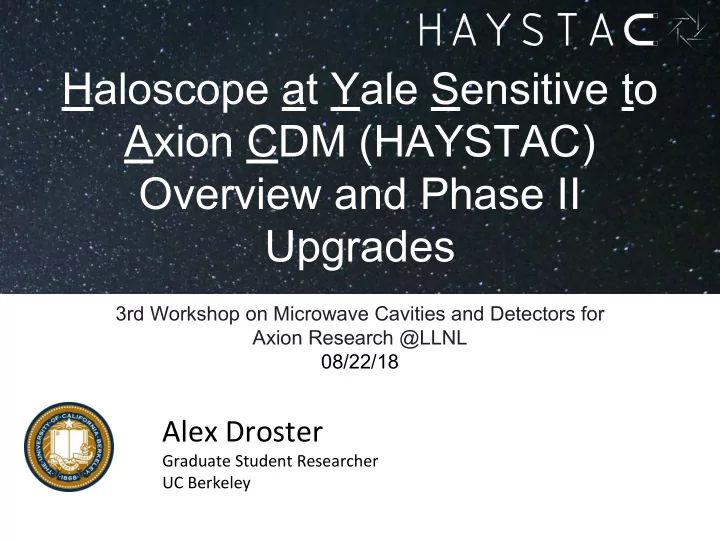

Haloscope at Yale Sensitive to Axion CDM (HAYSTAC) Overview and Phase II Upgrades 3rd Workshop on Microwave Cavities and Detectors for Axion Research @LLNL 08/22/18 Alex Droster Graduate Student Researcher UC Berkeley
Outline I. Reprise of microwave cavity experiment II. HAYSTAC Description III. Phase I Results ○ Exclusion plot ○ Hot rod problem IV. Phase II Upgrades and Outlook ○ Improved cryogenics ○ Squeezed State Receiver (SSR) V. Future Plans ○ PBGs and Metamaterials 2
Microwave Cavity Reprise 3
Cavity Experiment Overview • Sikivie 1983 PRL • Ann Rev ‘15 Graham,... • HAYSTAC PRL+PRD+NIM • ADMX ‘12 Du et al • More text 4
HAYSTAC Description 5
HAYSTAC Phase I Hardware Josephson Parametric Amplifier TM 010 -like mode: 3.6-5.8GHz 10.00” Copper microwave cavity Piezoelectric tuning mechanism ID: 4.00” S. Al Kenany, et al , NIM dia: 2.00” A 854 (2017), 11-24. 6
Cryostat and Magnet Cryostat Magnet ● Oxford dilution refrigerator ● Cryomagnetics, Inc ● Cooling power: 150 µW @127 mK ● Strength: 9 T ● Time to reach base temp (with load): ~3 days ● Field strength near JPA (with shielding): B ~ 1×10 -3 G ● ~8 hours to ramp from 0 to 9 T 7
HAYSTAC Cavity and Tuning Mechanism ● Copper plated stainless steel cylinder ● Off-axis copper rod tunes in 100 kHz steps ● Attocube piezoelectric for rotary motion ● Linear drives for antenna insertion and dielectric insertion (fine tuning) ● Quality factor (cold, unloaded): Q ~ 30,000 ● Form factor of TM 010 -like mode (simulated): C ≈ 0.5 3.6 GHz 5.8 GHz S. Al Kenany et al, NIM 854 (2017), 11-24 8
Hot Rod Problem and ad hoc Solution ● Excess noise due to tuning rod failing to reach base Run 1 (without fix) Run 2 (with ad hoc fix) ● T Rod = 600mK ● T Rod = 250mK temperature ● 40% reduction in Q ● Inserting copper rods into the axle mitigated this problem (see figure) ● 40% reduction in Q due to ad hoc solution Total ● Phase II will solve this problem at no expense to Q Added noise Cold load noise Cavity noise L. Zhong et al. , Phys. Rev. D 97 (2018) 092001 9
Phase I Amplifiers ● Single JPA ● 20 dB gain, quantum limited ● Tunable over 4.4-6.5 GHz ● Persistent coils for magnetic shielding 10
Phase I Results 11
Results from Phase I (2016-17) B. Brubaker et al. , Phys. Rev. Lett. 118 (2017) 061302 L. Zhong et al. , Phys. Rev. D 97 (2018) 092001 12
Results from Phase I (2016-17) KSVZ | for mass range 23.15 ≤ m a ≤ 24.00 µeV • Exclusion of | g � | ≥ 2.7 × | g � • First exclusion of QCD axion over 20 µeV 13
Phase II Upgrades and Outlook 14
Phase II Improvements � [GHz] m a [µeV] T SQL [mK] 0.5 2.1 24 5 21 240 20 83 960 Phase I ● Data run 1: T SYS ~ 3 × T SQL Hot rod problem ● Data run 2: T SYS ~ 2 × T SQL (40% reduction in Q due to ad hoc thermal link) New dil fridge Phase II Improvements Fix to hot rod problem , P ∝ Q Squeezed State Receiver 15
Improved Cryogenics • Cavity axle realigned for smoother tuning ⇒ reduced thermal noise for each tuning step • New tuning rod thermal link solves hot rod problem with no reduction in Q Q vs insertion depth Top Bottom 16
Improved Cryogenics, cont’ ● New BlueFors LD250 dil fridge ○ Improved vibration isolation ⇒ reduced thermal noise ○ 460 µW cooling power @100mK ● New variable temperature stage for calibration purposes ● Redesigned cavity support structure to mitigate damage in case of a magnet quench Quench damage (2017 power outage) 17
Squeezed-Vacuum State Receiver Phase I: Single JPA, double quadrature amplification Phase II: Two JPAs, one to create squeezed state, one for single quadrature amplification 2 4 1 3 4. Anti-aligned JPA amplifies cavity 2. Squeezer 3. Cavity injects 1. Coherent state noise in orthoganal produces squeezed coherent noise is produced quadrature state at some phase angle 18
Improvements from Squeezing ● Over couple and squeeze: search over a large bandwith ● Calculations include a realistic 32% power loss SNR vs Detuning Squeezing lowers noise floor Normalized SNR Over coupled, PSD (dB) squeezed Over coupled Critically coupled | � axion - Freq [GHz] � cav |/ � ℓ Projected 2.3X scan rate speed up in Phase II 19
Future Plans 20
Photonic Band Gap (PBG) Resonator Motivation ● TE modes don’t tune, causing mode crossings ● PBG structure confines TM modes while TE modes “leak” out Cavity TM 010 -like mode 21
Photonic Band Gap (PBG) Resonator, cont’ ● Periodic lattice of rods ● Resonator: defect in lattice confines disallowed modes ● All other modes propagate out 22
Conclusion 23
Conclusion ● HAYSTAC has excluded parameter space 23.15 ≤ m a ≤ KSVZ | where g � is 24.00 µeV to sensitivity |g � | ≥ 2.7 × |g � axion-photon coupling constant ● Upgrades to cryogenics and cavity will improve sensitivity and scan rate in Phase II ● Squeezed-vacuum state receiver will push noise below SQL and offers 2.3X scan rate enhancement ● Phase II data runs will begin fall 2018 ● R&D continues on novel cavity designs (PBG) ● R&D begins on single photon detection techniques , both qubit and Rydberg atom based 24
Thank you! 25
The HAYSTAC Collaboration Yale University (Host) Cady van Assendelft, Kelly Backes, Yong Jiang, Sidney Kahn, Steve Lamoreaux, Reina Maruyama, Danielle Speller UC Berkeley Karl van Bibber, Alex Droster, Saad Al Kenanay, Sami Lewis, Nicholas Rapidis, Maria Simanovskaia, Isabella Urdinaran CU Boulder/JILA Konrad Lehnert, Maxine Malnou, Dan Palken 26
Recommend
More recommend